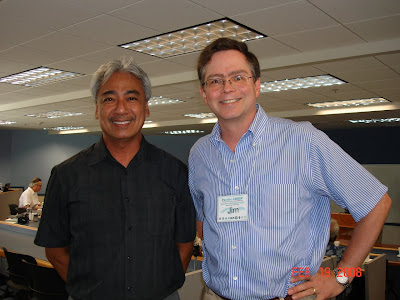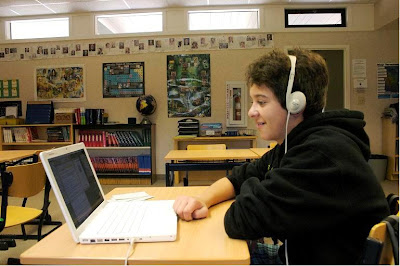Guam and the Consortium
The final stop for my Micronesia trip was Guam, a U.S. territory. Arriving on Guam felt like coming back to the United States, although it's more like Hawaii than the mainland!
Guam has a huge American military presence: the armed forces control about a third of the island. The presence is growing: the U.S. is relocating our units from Okinawa to Guam and this could grow the island's population anywhere from 20% to 40%. The military and tourism are Guam's two big industry. Japan is the biggest source of tourists for Guam, with growing numbers from other Asian nations like South Korea.

I enjoyed getting a chance to tour around the the southern part of the island with Mike Terlaje (U of Guam CEDDERS) and Chuck Hitchcock of CAST(pictured above) on my final afternoon there (and even squeezed in half an hour of snorkeling), and seeing Spanish ruins, waterfalls, and bay after spectacular bay. The native people of Guam are called Chamorros, and the language is resurgent. "Hafa Adai" is used frequently, pronounced "half-a-day," it means hello or goodbye, kind of like aloha in Hawaii. I acquired a taste for betel nut (a mildly stimulating palm kernel) and kelaguen(lime cured fish and chicken), among many other terrific foods. It's actually hard to get local cuisine in the restaurants, far easier to get Japanese food. But, Mike Terlaje invited Donna McNear and me over for a potluck party for one of his nephews and we had the chance to sample terrific local dishes made by his family for each other.

The centerpiece of the meeting on Guam was the first leadership meeting of the Pacific Consortium for Instructional Materials Accessibility Project, or Pacific CIMAP for short. The Consortium is made up of six island nations, commonwealths or territories: American Samoa, Commonwealth of the Northern Marianas, Federated States of Micronesia (including Chuuk and Pohnpei), Guam, Republic of the Marshall Islands and the Republic of Palau. The FSM, which is made up of four distinct island states (Kosrae, Pohnpei, Chuuk and Yap) sent teams from each of their states as well as the national government. We met with the special education directors and curriculum chiefs of each state. I also got to meet Gregg San Nicolas, with the Department of Defense Education Agency, who provided several of the pictures in this post (thanks, Gregg!).

We spent a day preparing, three days of meeting, and a morning of debriefing. The goal was to bring each of the key leaders from the island states up to speed on the NIMAS and NIMAC: the mandated and recommended elements of a strategy of delivering books to students with disabilities. Bookshare.org is a consultant to the Pacific CIMAP: our virtual library suits their geography as long as you can get access to the Internet. Although some of the island states are independent nations, they all implement U.S. education laws as part of receiving extensive funding.
The highlight of the meeting for me was showing off books in the local languages that the Bookshare.org team had already scanned or typed in, and which were already on the Bookshare.org website in our library. I picked one children's book, Grandma's Love, which is in both English and Chamorro. The voice synthesizer in the Victor Reader software did a good job on the English sentences, but drew many grins and smiles from the audience when it tried to speak the Chamorro. Not quite ready for students, yet! But, we're hoping to tune up the local language synthesis, or supplement our text e-books with human narration, which might be more practical.
By the end of the meeting, all nine entities had signed up for Bookshare.org and we're looking forward to getting their students the books they need!
Guam has a huge American military presence: the armed forces control about a third of the island. The presence is growing: the U.S. is relocating our units from Okinawa to Guam and this could grow the island's population anywhere from 20% to 40%. The military and tourism are Guam's two big industry. Japan is the biggest source of tourists for Guam, with growing numbers from other Asian nations like South Korea.

I enjoyed getting a chance to tour around the the southern part of the island with Mike Terlaje (U of Guam CEDDERS) and Chuck Hitchcock of CAST(pictured above) on my final afternoon there (and even squeezed in half an hour of snorkeling), and seeing Spanish ruins, waterfalls, and bay after spectacular bay. The native people of Guam are called Chamorros, and the language is resurgent. "Hafa Adai" is used frequently, pronounced "half-a-day," it means hello or goodbye, kind of like aloha in Hawaii. I acquired a taste for betel nut (a mildly stimulating palm kernel) and kelaguen(lime cured fish and chicken), among many other terrific foods. It's actually hard to get local cuisine in the restaurants, far easier to get Japanese food. But, Mike Terlaje invited Donna McNear and me over for a potluck party for one of his nephews and we had the chance to sample terrific local dishes made by his family for each other.
The centerpiece of the meeting on Guam was the first leadership meeting of the Pacific Consortium for Instructional Materials Accessibility Project, or Pacific CIMAP for short. The Consortium is made up of six island nations, commonwealths or territories: American Samoa, Commonwealth of the Northern Marianas, Federated States of Micronesia (including Chuuk and Pohnpei), Guam, Republic of the Marshall Islands and the Republic of Palau. The FSM, which is made up of four distinct island states (Kosrae, Pohnpei, Chuuk and Yap) sent teams from each of their states as well as the national government. We met with the special education directors and curriculum chiefs of each state. I also got to meet Gregg San Nicolas, with the Department of Defense Education Agency, who provided several of the pictures in this post (thanks, Gregg!).

We spent a day preparing, three days of meeting, and a morning of debriefing. The goal was to bring each of the key leaders from the island states up to speed on the NIMAS and NIMAC: the mandated and recommended elements of a strategy of delivering books to students with disabilities. Bookshare.org is a consultant to the Pacific CIMAP: our virtual library suits their geography as long as you can get access to the Internet. Although some of the island states are independent nations, they all implement U.S. education laws as part of receiving extensive funding.
The highlight of the meeting for me was showing off books in the local languages that the Bookshare.org team had already scanned or typed in, and which were already on the Bookshare.org website in our library. I picked one children's book, Grandma's Love, which is in both English and Chamorro. The voice synthesizer in the Victor Reader software did a good job on the English sentences, but drew many grins and smiles from the audience when it tried to speak the Chamorro. Not quite ready for students, yet! But, we're hoping to tune up the local language synthesis, or supplement our text e-books with human narration, which might be more practical.
By the end of the meeting, all nine entities had signed up for Bookshare.org and we're looking forward to getting their students the books they need!


Comments